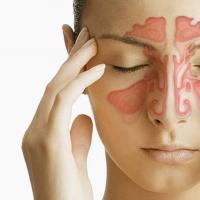Inflammation of the oral mucosa: causes, symptoms, treatment
Stomatitis - inflammation of the oral mucosa - a pathological process that develops on the internal surfaces of the oral cavity in the presence of certain etiological factors. The disease occurs at any age, however, children are more susceptible to it due to the peculiarities of the development of the jaw apparatus and the craving for a “tooth test” of foreign objects. The treatment of inflammation of the oral cavity is carried out by a dentist or, if the patient is in childhood, a pediatrician.
Stomatitis is considered only a superficial pathological process. Purulent-necrotic pathology affecting the deep layers of tissues of the oral cavity, gums and jaw bones does not apply to stomatitis. In this case, we are talking about gingivitis, subperiosteal abscess, soft tissue phlegmon. Stomatitis can be an independent disease or be secondary, being one of the symptoms of such internal diseases as:
- weakening of the immune system;
- herpetic infection;
- fungal infection;
- the presence of a source of infection from which the pathogenic microflora spreads throughout the body with blood
Primary inflammation in the mouth usually responds to topical treatment. Secondary stomatitis requires complex therapy, mainly aimed at eliminating the underlying disease.
Causes of stomatitis
The primary inflammation of the oral mucosa is based on the entry of an infectious agent into the "gate" of infection. The role of the pathogen can play:
- fungi;
- viruses;
- bacteria.
Non-infectious causes of stomatitis exist. We are talking about damage by chemical or physical factors (acid burn, thermal burn). However, in this case, the traumatic agent only creates an entrance gate, violating the integrity of the mucous membranes. As a rule, some types of pathogenic and opportunistic bacteria can be detected in the focus already in the first minutes after injury.
Damage to the internal surfaces of the mouth is often mechanical. The reasons for this phenomenon lie in the presence of sharp fragments of the tooth, the attempts of children to bite foreign solid objects, and improperly selected dentures. Bacteria get into the microtraumas thus obtained. Inflammation of the oral mucosa develops. With secondary stomatitis, the presence of an entrance gate of infection is not necessary. The microflora is brought in by blood from the main infectious focus.
Predisposing factors

Normally, a small amount of bacterial flora entering the wound does not lead to inflammation. Defense mechanisms are activated that destroy the pathogen. In order for the process to continue for any significant time, the degree of intensity of protective reactions must be reduced. This occurs in the following pathological conditions:
Inflammation of the oral cavity can also have an autoimmune origin. In this case, the patient's body begins to produce antibodies against its own tissues, destroying them.
Symptoms and Diagnosis
Symptoms of inflammation of the oral mucosa are divided into general and local signs. Local symptoms include:
- the appearance in the mouth of small ulcers, covered with a white coating and bordered by areas of hyperemia;
- swelling of the oral mucosa;
- bleeding gums;
- soreness of the mucous membranes when touched;
- bad breath;
- burning sensation;
- increased salivation.

As a rule, when trying to separate the white plaque, the patient experiences a sharp pain. The exposed surface of the ulcer bleeds in a capillary manner. The foci of the disease are more often located on the cheeks, the inner surface of the lips, the soft palate. Stomatitis of a viral nature manifests itself in the form of small vesicles with serous contents, which cover the mucous membrane. Her swelling and soreness is noted.
General symptoms develop with severe stomatitis and a high prevalence of inflammation. The symptoms that arise in this case are similar in an adult and a child and are mainly due to intoxication. Common symptoms of stomatitis include:
- an increase in the patient's body temperature sometimes up to 39 ° C;
- pain in muscles, joints;
- weakness, fatigue, tearfulness;
- headache;
- decrease or complete loss of working capacity;
- aches all over the body;
- flying pains in the bones.
Intoxication with stomatitis is caused not only by the release of bacterial waste products into the blood, but also by the decay of necrotic tissues. At the same time, in people with chronic kidney disease, accompanied by a decrease in their excretory ability, the general intoxication syndrome is most pronounced.
Against the background of intoxication and pain during swallowing, the patient may refuse to eat. An adult in such cases should be given liquid products. In the case of infants, it may be necessary to switch to parenteral (intravenous) nutrition or the placement of a nasogastric tube to introduce food directly into the stomach.
Treatment
In the inflammatory process of the oral cavity, treatment can be general and local.
Local treatment
Necrotic inflammation of the oral cavity requires careful treatment of foci of pathology. The ulcers are washed with a solution of baking soda. For processing, sterile infusion solutions of sodium bicarbonate, sold in 200 ml glass bottles, can also be used. Contact with ulcers should be made with a sterile or clinically clean gauze swab. It is worth noting that cotton wool is not used to treat ulcers. Microscopic pile may remain in the wound, which will complicate the process.
After treatment and discharge of white plaque, the ulcers are treated with antiseptic solutions. For this, miramistin, chlorhexidine, octenisept, a weak solution of potassium permanganate can be used. You can use some recipes of traditional medicine (decoction of chamomile). Such treatment leads to the fact that the inflammatory process subsides, giving way to regeneration.
After antiseptic treatment, ulcers are treated with agents that accelerate recovery. Solcoseryl, sea buckthorn oil can act as a regenerating drug. With severe pain, ointments with anesthetics (lidocaine, camistad) can be prescribed. The viral nature of stomatitis is an indication for the appointment of antiviral agents (acyclovir) to the patient.
The local treatment of stomatitis also includes the rehabilitation of foci of chronic infection in the mouth. Sick teeth are filled, destroyed teeth are removed or restored. If this is not done, the mucous membrane will become inflamed again and again.
General treatment
General therapy is used for severe stomatitis. Patients are prescribed such groups of drugs as:
- antibiotics (amoxiclav, metronidazole, ciprofloxacin);
- antiviral (acyclovir, zovirax);
- vitamins (complivit, injectable monovitamins);
- means that improve blood microcirculation (pentoxifylline, trental);
- immunostimulants (levamisole).
In addition to the above, general therapy should be aimed at correcting the underlying disease. Depending on the diagnosis, patients are prescribed immunomodulators, chemotherapeutic agents, antihistamines, and so on. The question of how to treat the underlying pathology is decided individually.

With stomatitis, a certain diet is required. Food products should not cause irritation of the mucous membrane and aggravate the course of the disease.
- citrus;
- fried foods;
- spicy food;
- excessively salty food;
- acid components;
- crackers; cookies, waffles, chips;
- hot dishes;
- alcohol.
The patient's table should consist of:
- mucous soups;
- dairy and sour-milk dishes;
- chilled tea, decoctions of medicinal plants;
- cottage cheese, yogurt;
- cereals from soft cereals;
- vegetable juices.
Before consumption, it is recommended to grind the products to a homogeneous mass using a blender. After eating, rinse your mouth with a decoction of medicinal herbs or an antiseptic. The lack of such treatment leads to the preservation of food particles between the teeth and the active reproduction of bacteria in the oral cavity. The sparing nature of nutrition should be maintained until the ulceration has completely healed.
As an alternative nutritional option for stomatitis (especially in childhood), specialized nutritional mixtures (nutrison, nutridrink) can be used.
Such compositions have a certain specialization, being intended for patients with diabetes mellitus, anorexia, etc. In order to feed a patient suffering from stomatitis, neutral compositions should be chosen that are as close as possible to natural food in content.
Prevention of stomatitis
Prevention of primary stomatitis is quite simple and should be done by every person who cares about their health. Inflammation of the oral cavity usually develops when the rules of personal hygiene are not observed. Therefore, the first and most important rule for preventing the disease in question is regular, twice a day, brushing your teeth with a soft toothbrush. At the same time, dentists do not recommend using a paste that contains sodium lauryl sulfate.
Do not forget that the causes of stomatitis often lie in the lack of vitamins. You should regularly, in spring and autumn, take a prophylactic course of vitamin therapy, eat seasonal fruits and vegetables that do not have an irritating effect. If you already have beriberi, you should consult a doctor to prescribe the appropriate treatment.
It is necessary to monitor the health of the oral cavity, to prevent the formation of microtraumas, to treat diseased teeth in a timely manner, if any are present in the oral cavity. You should also pay attention to other somatic diseases that can cause stomatitis. In order to timely identify and treat foci of pathology, it is recommended to undergo a preventive examination once a year, and after 40–45 years, 2 times a year.
Forecast
The prognosis for primary stomatitis is favorable. Recovery occurs on average 2-3 weeks after the onset of the disease. If the mucous membrane is inflamed for a longer period, the patient must undergo a comprehensive examination for the presence of diseases provoking stomatitis. Forecasts for the secondary form of inflammation directly depend on the main diagnosis and prognosis for it.



